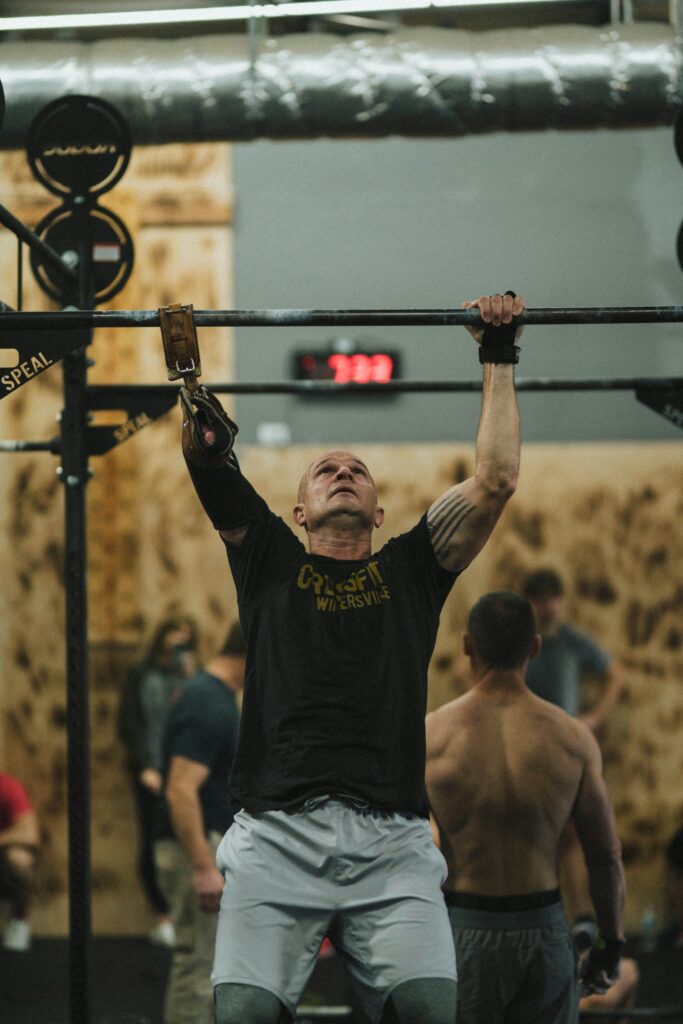Understanding CrossFit and Its Appeal
CrossFit is a high-intensity fitness program combining elements of weightlifting, cardiovascular exercise, and bodyweight training. Its universal scalability makes it suitable for all fitness levels. The community aspect of CrossFit is a significant draw for many. Athletes often find motivation and camaraderie through group classes and shared goals.
Key Features:
- Varied Workouts: Daily routines (WODs) challenge different muscle groups.
- Measurable Outcomes: Progress tracking through timed exercises and recorded lifts.
- Professional Coaches: Certified trainers provide guidance and prevent injuries.
- Community Support: Encouragement and accountability from peers.
CrossFit’s unique combination of varied, intense workouts and strong community support fosters both physical and social benefits.
Benefits of Joining a CrossFit Gym

Improve Overall Fitness
Joining a CrossFit gym enhances strength, agility, endurance, and flexibility through varied, high-intensity workouts.
Structured Programs
CrossFit gyms offer comprehensive programs designed by trainers to help members achieve their fitness goals efficiently.
Community Support
CrossFit gyms cultivate a strong sense of community, providing motivation and support from fellow members and trainers.
Professional Coaching
Members receive guidance from certified CrossFit trainers, ensuring correct techniques and reducing injury risks.
Scalable Workouts
Exercises can be adjusted to match any fitness level, making them accessible for beginners and advanced athletes alike.
Setting Your Budget for a CrossFit Membership

To determine the budget for a CrossFit membership, consider monthly and annual expenses.
- Membership Costs:
- Basic memberships typically range between $75 and $150 per month.
- Premium memberships can cost between $200 and $300 per month.
- Additional Fees:
- Initial sign-up fees.
- Costs for drop-in classes are usually $20 to $30.
- Charges for special courses or advanced coaching.
- Equipment Needs:
- Personal gear like shoes, gloves, and supplements.
- Travel Expenses:
- Calculate the cost of going to the gym.
Budgeting should be comprehensive, including all potential costs.
Researching Local CrossFit Gyms
- Identify nearby gyms using maps and review websites.
- Visit official gym websites to gather information.
- Check for certifications of trainers and gym accreditation.
- Examine membership plans and fee structures.
- Look for gyms offering free trial classes or drop-in rates.
- Verify the variety and timing of classes.
- Read user reviews to assess gym atmosphere and cleanliness.
- Inquire about equipment quality and availability.
- Consider the location for ease of commute.
- Discuss with current members about their experiences.
- Assess the gym’s safety protocols and COVID-19 measures.
Reading Reviews and Testimonials
Examining reviews and testimonials can be crucial when selecting an affordable CrossFit gym. Consider the following steps:
- Online Platforms
- Check Google Reviews, Yelp, and social media for ratings and feedback.
- Look for consistent themes in the feedback to gauge reliability.
- Quality of Testimonials
- Assess the authenticity of testimonials on the gym’s official website.
- Focus on detailed experiences rather than generic praise.
- Community Engagement
- Join local fitness forums and ask for recommendations.
- Engage with current and past members to get firsthand insights.
Gathering varied perspectives helps in making an informed decision.
Utilizing Online Resources for Discounts

Exploring online resources is imperative when searching for affordable CrossFit gyms. Prospective members should:
- Visit Deal Websites: Websites like Groupon and LivingSocial frequently offer deals and discounts for local gyms and fitness programs.
- Check Gym Websites: Many gyms list special offers or discounts for new members directly on their websites.
- Join Mailing Lists: Subscribers often receive exclusive discounts and early notifications about promotions.
- Utilize Fitness Apps: Apps like ClassPass provide access to various gyms, sometimes at a discounted rate.
- Engage on Social Media: Following gyms on platforms like Facebook or Instagram can reveal flash sales or promotional offers.
Professionally leveraging these resources can result in significant savings.
Touring the Facility and Asking the Right Questions
When touring a CrossFit gym, it’s crucial to evaluate cleanliness, equipment quality, and member engagement. Begin by observing the condition of the floors and restrooms. Top-quality gyms maintain high standards of hygiene.
Key questions to ask:
- What are the membership fees? Understanding the cost structure ensures affordability.
- What certifications do the coaches hold? Certified coaches guarantee a safer, more effective training experience.
- How is the class schedule structured? Ensure flexibility that suits personal availability.
- Are trial sessions offered? Trial sessions provide firsthand experience without commitment.
- What is the trainer-to-client ratio? Lower ratios tend to offer more personalized attention.
Evaluating the Coaching Staff
- Certifications and Experience:
- Verify CrossFit Level 1 or higher certifications.
- Look into years of experience in CrossFit and other fitness disciplines.
- Communication Skills:
- Observe if coaches provide clear, concise instructions.
- Notice their ability to motivate and engage athletes.
- Class Management:
- Evaluate how well coaches manage class sizes.
- Check if they can provide individualized attention despite group settings.
- Client Feedback:
- Seek reviews or testimonials from current or former members.
- Pay attention to feedback on coaching effectiveness and professionalism.
- Professional Development:
- Ask if coaches participate in continuous education.
- Investigate their interest in staying updated with fitness trends.
Participating in Introductory Classes
Attending introductory classes offers valuable insights for anyone considering CrossFit gyms. Many gyms provide free or low-cost introductory sessions.
- Take Advantage of Trial Offers: These allow firsthand experience.
- Evaluate Coaching Style: Observe how trainers interact with beginners.
- Assess Facility Quality: Ensure equipment and space meet safety standards.
- Understand Community Vibe: A supportive atmosphere is essential.
- Gauge Programming: Confirm the workout structure suits fitness goals.
Consider the following when attending an introductory class:
Asking current members about their experiences can provide additional insights into the gym’s environment and long-term value.
Considering Off-Peak Membership Options
One strategy for finding affordable CrossFit gyms is to examine off-peak membership options. Off-peak hours are typically mid-morning or early afternoon, outside the rush of regular gym times. This alternative offers various benefits:
- Lower Rates: Many gyms provide discounted rates for off-peak memberships.
- Less Crowded: Members may experience less crowding, enabling more personalized attention.
- Flexible Schedules: Ideal for those with non-traditional work hours or flexible schedules.
When researching gyms, inquire about available off-peak memberships. This option can provide significant savings while still offering access to quality CrossFit training and facilities.
Negotiating Membership Fees
When seeking affordable CrossFit gyms, one should consider negotiating membership fees.
- Timing: Approach discussions at the end of the month or year, as gyms may be more flexible to meet quotas.
- Comparative Research: Present competitor prices to leverage negotiation.
- Group Discounts: Inquire if the gym offers discounts for groups or family memberships.
- Trial Periods: Suggest a trial membership to demonstrate commitment before discussing long-term rates.
- Additional Discounts: Ask about student, military, or corporate discounts.
A respectful and informed approach often yields favorable outcomes in reducing fees.
Understanding Additional Costs and Hidden Fees
When assessing CrossFit gym memberships, the quoted price may not reflect total expenses. Potential additional costs and hidden fees include:
- Initiation Fees: Some gyms charge one-time setup fees.
- Annual Maintenance Fees: These may cover facility upgrades and equipment maintenance.
- Specialized Classes: Participation in certain classes might incur extra charges.
- Equipment Costs: Personal gear such as weightlifting belts or specific shoes might be necessary.
- Late or Cancellation Fees: Fees for missed classes or late cancellations may apply.
- Nutritional Plans: Some gyms offer dietary guidance for an additional fee.
Always clarify these aspects before committing to a membership.
Seeking Community Recommendations
Tapping into local communities can be a valuable resource for finding affordable CrossFit gyms.
- Online Forums: Websites like Reddit and local Facebook groups often have discussions and reviews.
- Word of Mouth: Ask friends, family, or coworkers if they know of any budget-friendly options.
- Local Meetups: Attend fitness or CrossFit meetups to gather firsthand recommendations.
- Neighborhood Apps: Platforms like Nextdoor can provide localized information and feedback.
- Fitness Enthusiasts: Engaging with members of sports clubs or fitness societies may yield insights.
Community recommendations can provide honest feedback and often reveal hidden gems.
Balancing Cost with Quality of Training
Finding affordable CrossFit gyms involves evaluating the cost without compromising the quality of training. Consider the following strategies:
- Trial Classes: Evaluate quality through no-cost or low-cost trial sessions.
- Instructor Credentials: Verify trainers’ certifications and experience.
- Class Size: Smaller classes often result in personalized attention.
- Facilities: Ensure gyms are well-equipped and maintained.
- Community Reviews: Read reviews and ratings for insights on member satisfaction.
- Membership Plans: Look for gyms offering flexible membership plans.
- Additional Services: Assess the value of added services like nutrition counseling and personal training.
These considerations help identify well-equipped gyms offering quality training without excessive costs.
Personalizing Your Search for the Ideal CrossFit Gym
Assessing Individual Fitness Goals
Understand personal fitness objectives. This informs gym selection, ensuring relevance to fitness aspirations.
Evaluating Location and Schedule
Analyze gym proximity to home or work. Check class schedules to align with personal availability.
Investigating Coaching Credentials
Review coach qualifications. Certified trainers are essential for safe and effective CrossFit experiences.
Touring Potential Gyms
Visit possible gyms to gauge atmosphere and equipment quality. Note cleanliness and available amenities.
Comparing Member Reviews
Read reviews from current members. Positive feedback indicates a supportive community and quality programs.
Monitoring Cost and Commitment
Evaluate membership options and costs. Balance affordability with value. Look for flexible terms and trial periods.